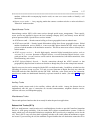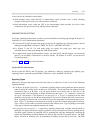1-42 TRUNKING
_ ___________________________________________________________________________________________________________________________
_ ___________________________________________________________________________________________________________________________
_ ___________________________________________________________________________________________________________________________
• Framing — On System 85 and G2, you can administer a DS1 port for either D4 or ESF framing
through PROC 260 Word 1, field 6. On System 75 and G1, use the DS1 Circuit Pack Screen to set
these options.
• Signaling — On System 85 and G2, you can administer a DS1 port for signaling through PROC 260
Word 1, fields 8 and 14. On System 75 and G1, use the DS1 Circuit Pack Screen to set these options.
The DS1 options appropriate for a given application are given in tables 1-10 through 1-13.
INTERFACE CIRCUIT
Table 1-2 provides a list of the circuit boards used with particular trunking applications. The tables printed
on the remaining pages of this chapter tell you which circuit board to use given the trunking application,
connectivity, administration options you choose.
TRUNK TABLES
The tables shown on the next few pages tell you how to administer a trunk on the Generic 1 or Generic 2
communications system, given the trunk application and service options. The tables are organized so you
can find the information you need when you are administering your network. That is, analog and digital
trunks are described in separate tables, and, for digital trunks, there are separate tables for the following
DMI modes. The DMI modes that the tables cover are as follows:
• Mode 0, 2*, 3 — 64 kbps channel
• Mode 1 — 56 kbps channel
Note that administrative options given for Generic 1 trunk connections are the preferred options when the
trunk connects a Generic 1 to a Generic 2. The options will also work for trunks that link Generic 1s
together, but other options are possible.
__________________
* Although mode-2 DMI transmits subrate data up to 19.2 kbps, mode-2 data is listed with modes 0 and 3 because mode-2 DMI
protocol accommodates the subrate transmission to a 64-kbps clear channel.


















